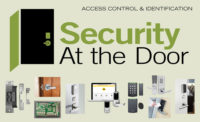According to the IHS Markit Physical Security Equipment and Services report of September 2016, the global access control market is positioned to grow from $3.69 billion in 2015 to $5.16 billion in 2020. During this growth period, there will be three key trends that will have a significant impact on the business of security dealers, installers and integrators — the continued development of IP-enabled equipment; mobility; and a greater focus on software-based revenue generation as part of Access Control as a Service (ACaaS).
1. Proliferation of IP-Enabled Equipment
As the Internet of Things (IoT) continues to expand at a rapid rate, the intersection of IT and physical security is more critical than ever. IP-enabled equipment allows facilities to leverage their existing IT infrastructure to expand access control more easily and affordably. Integrators need to be knowledgeable in these solutions in order to deliver more value to their customers, and to ensure successful deployments. This requires the ability to work effectively with both security and IT departments for a comprehensive and holistic approach that provides the greatest efficiency and level of protection for their customers.
Along with convergence comes the opportunity to reduce or combine budgets. Now that IT and physical security are often using the same equipment and infrastructure, investment costs for each department can be reduced. For example, smart card or mobile phone solutions can be used for both IT applications (network logon or secure printing) and physical security (to gain access to the building itself or areas within the building). The ability to gain additional utility not only helps lower the costs for each department, but also simplifies management, because a single credential is being used across multiple applications.
2. Mobility
While the proliferation of IP-enabled equipment represents an opportunity for integrators to grow their business by securing a greater percentage of a facility, the growth in connected solutions combined with declining hardware prices is driving solutions providers to search for new revenue streams. This leads to another important technology trend — mobility.
Mobility will impact the integrator in two ways: 1. mobile credentials and 2. the ability to manage access anywhere, anytime, and from any device.
With the majority of the population now relying on their mobile phones for managing nearly every aspect of their lives, mobile credentials will soon become a requirement for many customers. The number of mobile-ready locks and readers that are currently deployed in the field will make it that much easier for customers to begin using mobile credentials without the upfront cost and challenges of installing new hardware. Additionally, there is a comfort level with the technology and security level that will accelerate adoption. This presents a significant opportunity for integrators to grow their businesses through recurring revenue streams from managing mobile credentials.
Mobility is also a critical consideration in terms of access control management. In today’s mobile society there is a growing expectation to be able to manage access from anywhere, not just the office. This drastically impacts the way that access control software is delivered. Cloud-based services offer a secure, manageable and cost-effective approach without the need for expensive infrastructure. These advancements provide the ability to manage access privileges from any device, from anywhere that has an Internet connection. This eliminates the need to be on-site or invest in dedicated computers, servers and other IT maintenance requirements.
This is particularly true in the multi-family market, which faces many complex security challenges. Until now, multi-family properties have been forced to choose between enterprise-level access control systems that are often too complex and expensive for their needs, hospitality systems that require visiting each lock for updates or audit trails, or key-based mechanical locks that lack accountability. Due to the advancement of lock technologies, cloud-based software, and smartphone/tablet integration, it is now possible to deploy a secure, manageable, and cost-effective multi-family housing solution without the need for complex and expensive infrastructure. These advancements give property managers and security professionals the ability to manage access privileges from any Internet-connected device.
3. Access Control as a Service
An increased focus on revenue generating services such as cloud-based software and mobile access control is driving the growth of ACaaS. ACaaS is a system where a customer pays on a regular basis (typically yearly, monthly or quarterly) for a server that manages the access control system to be housed at a third-party location, rather than having software or servers located on the customer’s premises.
This service-driven business model generates recurring revenue for access control providers and systems integrators of all sizes, and opens the door to new, high-growth markets such as small to medium enterprises or multi-family housing, where access control was previously not an option, because of high upfront costs.
As forecast by IHS Markit, the service and maintenance market will be the fastest-growing sector globally (Americas, EMEA, and Asia) from 2015 to 2020. The regular and predictable revenues of service and maintenance contracts are beneficial to the integrator, and provide an excellent opportunity to enhance customer relationships, opening the door to more future business. ACaaS will see the greatest growth in North America because there is good Internet infrastructure and a familiarity with cloud-based solutions.
These three key trends demonstrate that the proliferation of new technologies continues to change the mold of the physical security industry and its relationship with IT. It is critical for security dealers, installers, and integrators to recognize these changes. Leveraging emerging technologies, such as IoT and mobile access control, and adopting new service-driven business models will allow you to grow your business within your existing customer base and in new markets.
About the author: Peter Boriskin is the vice president of commercial product management for ASSA ABLOY Americas. Boriskin has over 20 years’ experience working with security technology, most of that in the enterprise security marketplace. He is a member of a number of industry forums and working groups and was part of the founding team for the Open Security Exchange. He is also an active member of ASIS International.







